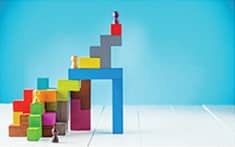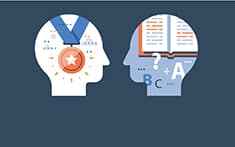
Professional… Development
November 28, 2018
Are We Our Teachers’ Keepers?
November 28, 2018RABBI SHIMSHON GEWIRTZ
I
remember the first faculty meeting I ran a bit sheepishly. Shortly after assuming my role as general studies principal in a yeshiva high school, I held a faculty meeting to lay out my vision for our department. I told the assembled group that I was hired to help create a great program. An astute teacher at the meeting asked me what would be great about our program. He was right to ask; what did I think makes a program great? At the time I was stumped, but with time to reflect and speak to others I realized that a great program is one that is always improving. The way to greatness is for a program to be on the path to improvement, learning from experience and getting better each year.
In my case, I decided to embark on the kinds of projects that lead to school improvement, including curriculum mapping, clarifying or changing policies and procedures, fostering greater internal communication, and encouraging collegiality and professional learning. Some of these ideas were immediately popular; who doesn’t like the sound of better communication or more collegiality? Others were less popular; curriculum mapping, for example, is an extra out-of-class burden for teachers. And even collegiality and professional learning can be a burden since they don’t always happen neatly and during the school day.
This is the challenge of school improvement. It’s been said – and it sounds right to me – that a school is only as good as its teachers. And it’s obvious that school improvement efforts depend on the willingness of the teachers – the front line – to embrace them. Perhaps it could therefore be argued that in order to have real school improvement it is most important for teachers to view themselves as professional educators – teachers who do their jobs with professionalism. A good teacher, like any other professional, is engaged in the continuous process of improving and learning. A professional who is always improving and learning will be open to the opportunity to try new things, learn from mistakes, and take on new roles.
While some teachers will naturally embrace this culture, there will also be some who may stonewall a new project or create discontent among their colleagues when the principal introduces a new initiative. It happened to me pretty early on. A math teacher cornered me one day after I had spoken to my faculty about curriculum mapping and asked me – angrily – if I thought he knew more about teaching math than the smart men and women who wrote the textbook. His point was that there should be no expectation for classroom teachers to have a role in, or responsibility for, curriculum decisions and that it should be sufficient for us to trust that our math textbooks are based on reasonable curricular goals.
Why was he wrong? He was a capable high school math teacher and never sought to become a scholar nor pursued a doctorate in mathematics or curriculum development. Any research, thoughts, or suggestions he could muster wouldn’t make him more of an expert than the textbook authors. I think the reason he was wrong was that his perspective was non-professional. As a high school teacher for many years, he should have had the professional curiosity to learn more about the way a high school math program is mapped and scaffolded. He should have been interested in exploring why things are taught in a specific order or why some skills are taught and others are left out (and why we seem to think it’s wise to insert a year of geometry in between two years of algebra.)
A teacher with a more professional perspective would have relished the opportunity to be involved in this kind of process, deciding what he should be teaching and why. This kind of teacher may also enthusiastically consider a new discipline protocol that might help him manage his classroom, or proposed accommodations for a student with learning differences. A school with teachers who are always seeking to learn and improve is on the path towards improvement and can be described as great.
Professional curiosity has other benefits. A parent related that he was called to a meeting in his first-grade son’s school because his son was struggling with reading. One of the school staff began the meeting by summarizing results of the boy’s reading testing and mentioned that he was only able to independently read books at a certain Lexile score. The staff member sheepishly admitted that she didn’t know what a Lexile score was, but his score was lower than it should have been. The parent continued to take part in the discussion, but when someone had to step out for a minute and there was a break he took out his smartphone and Googled “Lexile score.” He related to me that it only took him about 15 seconds to learn what a Lexile score was and what his son’s score really meant, and he was turned-off by the fact that the staff member didn’t have the curiosity and professionalism to invest those 15 seconds herself. (Hint: Put this article down for a moment and Google “Lexile score.”)
How can you create this atmosphere of professional learning and growth in your school? People talk about schools being communities of professional learning, but where does the cycle of learning start? If we hope to create great programs, staffed by good teachers who are engaged in the continuous process of improving and learning, the professionalism has to start with the school leaders.
Often, the best way to get others to do something we want is to lead by example. Teachers should see school leaders engaged in ongoing professional learning. The principals in turn, can share some of what they’re learning with their faculty (even if it’s not entirely relevant to them.) One way to do this is to include a “What I’m Reading” section in a weekly or monthly staff memo. When teachers see that their supervisor values learning – even if it can be messy and disruptive to the status quo – it creates the professional learning atmosphere that is desired.
Another way to engender professionalism among teachers is to act with humility. No one gets it right every time and the important thing is to be open to learning from mistakes. If a tough conversation goes poorly the principal can ask a teacher who was part of the conversation for feedback and input as to how that type of discussion can be better managed next time. I always like to ask teachers what they would like me to look for when I observe them, and part of the message I’m sending is that I don’t know “it all” and am looking to become a better observer each time I do it.
Scheduling gives the principal the opportunity to build professionalism into the day. By giving teachers paid planning time, a school recognizes the work teachers do out of class to create good lessons. This time may also be used for professional learning, and if it is, the teacher should be given the opportunity to share this learning with his or her colleagues.
The most important thing a school leader can do is cultivate a culture of professionalism in a school. School leaders who are curious and learning can get the other adults in their schools to be open to change, honing their craft and ongoing professional learning, by viewing themselves as professional educators. A school staffed by professional educators may not be perfect, but it will be continuously improving, attuned and responsive to the learning and needs of its students, and may truly be considered a great program.
Rabbi Shimshon Gewirtz, M. Ed., teaches ninth grade and serves as the general studies principal at Missouri Torah Institute, a yeshiva high school in St. Louis. He is the editor of the CoJDS Journal of Jewish Day School Leadership. He received semicha from Yeshiva Chofetz Chaim and is a graduate of Loyola University Chicago. Contact Rabbi Gewirtz at [email protected].

